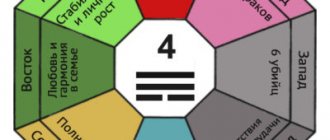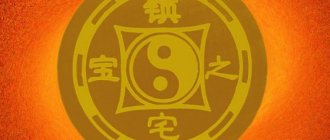Mantra (Sanskrit: मन्त्र) has three interpretations of literal translation:
- “an instrument for carrying out a mental act”;
- "liberation of the mind";
- “verse”, “spell”, “magic”;
It is a sacred text, word or syllable, the distinctive feature of which is the requirement for accurate sound reproduction.
For people who practice yoga, meditation, pranayama, this is a way of calming and relaxing through sound vibrations. There is an opinion that mantras help a person fulfill his desires, recover from illnesses, find love and various earthly blessings.
For every goal and desire there is a mantra:
Bija mantras.
Also known as “seed mantras”. They are a kind of prayers containing one or more sounds/syllables. As the masters say, bija mantras have greater power than all others, since they contain energy, the spiritual power of a particular Creator. It is for this reason that very often, in order to enhance the power of other mantras, syllables from the bija mantra are added to them;
Gayatri mantra. Written in Sanskrit, characterized by the poetic meter “gayatri”, consisting of 24 syllables. This is one of the most revered mantras, it is dedicated to Savitar (solar deity). According to mythology, Savitar made pilgrimages throughout the earth and through his bright light brought strength and longevity, and also drove out evil spirits. Legend has it that this deity transports the souls of the righteous with the help of his golden chariot;
Mahamrityumjaya mantra. It is believed that through repeated reading of this mantra, metabolic processes in the body are restored, the aging process is stopped and the human physical body is rejuvenated. Prescribed in difficult, sometimes even hopeless situations, it neutralizes the adverse effects of the planets, while healing, giving energy, self-confidence and spiritual strength;
Mantra Om. It is primary, it contributed to the creation of the entire universe. Helps to open one’s own energy channels, calm the mind and relax the body, clears the mind and thereby gives a person the opportunity to rise to the next stage of internal development;
Om Mani Padme Hum.
The sages believe that this mantra contains all eighty-four thousand teachings of the Buddha. It helps cleanse the body, speech and mind;
Om namah Shivaya.
Perhaps one of the most famous mantras in the whole world, it is considered universal, that is, it is used not only to fulfill a specific desire, but before any fateful event or for improvement in the daily practice of the spirit;
Panchabrahma mantra.
Consisting of six syllables, this mantra of the five faces of Shiva: Sadyojata (creation), Vamadeva (sustainment), Aghora (destruction), Tatpurusha (hidden mercy), Ishana (manifest mercy);
What are mantras?
As spiritual practices such as yoga and meditation become even more popular, more and more people are becoming interested in mantras. But what is a mantra and how can you harness its power?
In modern spiritual practices, the word “mantra” has become as mainstream as “intention.” But in reality these are different concepts. The word mantra can be broken down into two parts: man, which means mind, and tra, which means vehicle. In other words, mantras are a tool of the mind—a powerful sound or vibration that can be used to enter a deep state of meditation.
Like a seed planted with the intention of blooming into a beautiful perennial, a mantra can be thought of as a seed to activate your intention. Just like you plant a flower seed, you plant mantras
into the fertile soil of spiritual practice. You cultivate these seeds by practicing mantras, and over time they bear the fruit of your intention.
Read also:
- The effect of esotericism - when it occurs
- Human mental activity - why is it needed?
- How to turn on the vajra - an artifact of protection
- Mantras for health and healing - 13 collections
- Protecting children at home - mantras and talismans
- Result from esotericism - a period of 363 days
- The meaning of mantras is a means of transmitting thoughts
- Button amulet is a well-known sign
Mantra in meditation
Mantras
can be spoken, sung, whispered, or repeated in your mind.
Most mantra meditation techniques have two main components: mindfulness meditation and mantra
or chanting.
Although this ancient practice is known to have Buddhist and Hindu roots, forms of "sacred word" recitation exist in a wide variety of spiritual traditions, including Judeo-Christian and shamanic.
Currently practicing mantra
is also gaining popularity as part of mindfulness practice.
People meditate on mantras
for different reasons. For some, this practice serves as a form of mental defense against unwanted distractions or emotions, such as when fighting insomnia or overcoming travel fears.
For others, mantra meditation serves a deeper spiritual purpose. In some Hindu and ancient Christian traditions, for example, the recitation of mantras is used to center the mind and connect with the divine, both within and without.
In Buddhism, one of the benefits of reciting mantras is that it helps keep the mind focused and receptive to the blessings of the present moment. Since Buddhism is a non-theistic tradition, Buddhist mantras
serve to evoke positive qualities and confidence rather than an external deity.
History of appearance
Sound energies have always existed. They were discovered thousands of years ago by ancient sages. During their meditations, they heard a repeating sound vibration. It could vary in power, sometimes being a manifestation of cosmic consciousness, and sometimes a correspondence to various natural phenomena.
The prophets wrote down mantras in the Vedas.
The prophets gave sounds the form of words and wrote them down in the Vedas. Over time, in Buddhism and Hinduism, mantras began to be called not only verses from this sacred book, but also other phrases that have an enlightening effect on the mind.
Mantra in yoga: setting intention
In many yoga studios, classes begin with the instructor sharing the topic of the class. He or she may encourage participants to set an intention for their practice and may also offer suggestions for using mantras during the practice. Mantras such as “I am strong,” “I am centered,” or “I am letting go” can help the practitioner stay connected to the state they want to develop during their time on the yoga mat.
This mantra is used in silent repetition during asanas to help keep the mind focused. They say that in yoga, asanas are body postures, and mantras are
postures of the mind.
Mantras
, used in this way, are more like affirmations and help to maintain connection with a specific state of mind.
When they start to act
After the first 2 meditations, you may not notice any changes, because... the body and brain are still adapting to the new state.
What happens next depends on the goal:
- To calm your nerves or clear your mind before difficult work, 15 minutes of chanting a mantra will be enough.
- It will take about a month to notice the beneficial effects of prayer on your health.
- To change your destiny, you need at least six months of practice.
Spells begin to work from the very first meditation, but this is such an unobtrusive process that the degree of impact can be assessed only after some time.
Mantra: the sacred language of Sanskrit
Mantra, in its essence, is the basis of all religious traditions, scriptures and prayers. According to Pandit Vamadeva Shastri (Dr. David Frawley), when mantras are carefully selected and used, they are believed to be able to help change your subconscious impulses, habits and relieve suffering.
Mantras, spoken or chanted, channel the healing power of prana (life force energy) and in traditional Vedic practices can be used to activate and access spiritual states of consciousness.
Mantra as a spiritual practice should be performed regularly for several months to achieve the desired effect.
Mantras can help you return to a light and simple approach to life and focus on those things that inspire you and truly make you happy.
Effect and result of application
A person already has a model of the future projected in his consciousness. It is often formed on the basis of conventions, blocks, complexes, lack of self-confidence, etc. The mantra liberates and cleanses the mind from destructive influences. Under its influence, a person changes his attitude towards his dreams, thoughts, and himself.
The mantra clears the mind of destructive influences.
His worldview changes, he begins to make the right decisions. As a result, his life and future change.
How to start practicing mantras
First you need to choose a mantra that you will practice. We'll tell you how to do it in 5 steps!
Decide on a goal
First of all, honestly answer yourself the question: what do you want most? Perhaps you have a certain desire, aspiration. What is important to you? Calm? Love? Health? Harmony? Overcoming fear? Success in business? This is the first step to understand what mantra
best suits you right now.
Now turn to a selection of mantras depending on the topic that corresponds to your deepest desire. To do this, you can use our articles, where you will find mantras
of love
,
mantras of happiness
,
mantras of health
, mantras for attracting money, mantras for good luck, and mantras that clear away negativity.
Read about the purpose of each mantra, find out how their texts are translated from Sanskrit. Realize the deep meaning of the mantra - it should resonate in your soul.
Use your intuition
When it comes to spiritual practices, intuition is the best assistant and truly worthy of trust. Intuition will help you quickly understand which mantra
suits you, use this strength at the initial stage of selection.
You can listen to mantras
, try saying different mantras and listen to your inner feelings.
If you don’t like any sound in the text of the mantra or have difficulty pronouncing it, accept it, this is simply not the mantra that you need right now, look for another one. Each of us contains enough inner wisdom to understand how much the mantra
“It hits the soul.”
Listen to your body
How do you feel at the moment of pronouncing the mantra? Is your emotional and maybe physical well-being changing? If this is truly your mantra, you should most likely observe the following changes:
- lightness in the head and body;
- bad thoughts seem to dissolve (later you will feel “emptiness” in your mind - this is complete immersion in the process of reading the mantra);
- growing warmth in the lower chest, smoothly spreading throughout the body;
- pleasant vibration in the back of the head and neck.
Try it right now by listening to this mantra of love and tenderness
:
What do you feel? Do you feel similar when reading or listening to another mantra? If yes, you can be sure that this is exactly the mantra that will help you harmonize your state and get closer to your desired goal.
Do you want to learn useful practices, draw up your natal chart and find out the future?
Then watch our free webinar and get answers to the most important questions. Register on this page and we will send you a link to the webinar
4. Try it!
It is impossible to understand how to choose a mantra and whether you have chosen the right one unless you try. Give your mantra a trial period: practice reading it regularly for at least 2-3 weeks and listen to yourself - are you attuning to the energy of the mantra?
Start by reciting the mantra slowly, then try speaking a little faster to keep your speech flowing. Then read the mantra quieter and quieter until you switch to your inner voice - this is the correct reading.
Be constant
When you think you have found your mantra, focus only on it. Don't jump from one to the other and change the mantra every few days. Meditate on this mantra. Go to a quiet place, get comfortable, close your eyes and mentally repeat the text of the mantra to yourself. Throw all thoughts away, don’t even think about the meaning of the mantra - concentrate on the inner sound. Meditate for at least 15-20 minutes.
To understand whether you have chosen the right mantra, be sure to practice reading it or meditating for at least 21 days - this way you will develop a habit and you will feel exactly how effective this mantra was for you.
Once you understand that the mantra is yours, use it not only during meditation, but also throughout the day: when driving to work, washing dishes, or walking the dog. The more regularly and often you consciously practice reading your mantra, the better it will work, and therefore bring you closer to your cherished goal.
Main varieties and their characteristics
There are many mantras; for almost every human wish there is a set of sounds that fulfills it. According to their meaning and meaning, prayers are divided into several groups.
Saguna
Contains the name of God, who awakens under the influence of sound vibration.
Prayer has 6 features:
- She has a prophet. The rishi (sage), recognizing the voice of the deity during meditation, passed on the knowledge to his disciples.
- She has a patron deity.
- She has a special power - “bija”, i.e. “grain”, “seed”, “potency” - and contains information about the past and future. This force is the basis of any beginning, be it sound or thought.
- It has a poetic meter.
- Has dynamic strength.
- Has kilaku. This is like a cork that seals the pure consciousness hidden in the mantra. Frequent repetition creates energy that dislodges this wedge and allows one to achieve enlightenment and see divine visions.
Rishi passed on knowledge to his disciples.
It is important to pronounce Saguna spells carefully and accurately, because they contain the name of God. The slightest distortion of a verse changes its meaning; the text ceases to correspond to the deity and cannot awaken him.
Nirguna
They do not have divine personalization. Such mantras are practiced by people who do not worship any god or profess a religion. These abstract prayers help to achieve unity with the Higher Mind, with the energy of the Universe.
Their meaning is accurately conveyed by the literal translation of the famous Vedantic phrase “Tat Tvam Asi”: That (Brahman, deity) is You (reading the mantra).
Bija
The seed mantra is considered the basis of the foundations and has powerful creative energy. They are short phrases or syllables that have no semantic meaning. They affect human energy channels and centers.
Bija is considered the basis of the foundations.
Each chakra has its own bija:
- muladhara—LAM;
- svadhisthana - YOU;
- manipura - RAM;
- anahata—YAM;
- visuddha—NAM;
- ajna - OM;
- sahasrara - AUM.
Bija is often included in other mantras to enhance their effect.
Gayatri
A set of words of 24 syllables is dedicated to the Sun God - Savitar. He bestows health and longevity, expels evil spirits, and also transports human souls to another world.
This mantra works on 3 levels:
- earthly (Bhur);
- astral (Bhuvah);
- heavenly (Matchmaker).
Gayatri gives a person longevity.
Of all the mantras, Gayatri is considered the most powerful.
Ohm
The sound of the primal principle, containing the vibration of the creation of the Universe. Symbol of the triune deity (Trimuti).
The triad includes:
- Brahma (creator);
- Vishnu (preserver);
- Shiva (destroyer).
OM consists of 3 letters (A - U - M), symbolizing states of consciousness:
- wakefulness - A;
- drowsiness - U;
- dream - M.
Repeating the mantra of the universe allows a person to realize his destiny and achieve nirvana.
Hare Krishna
The 16-syllable “mahamantra” refers to the names of the god Krishna:
- Krishna (All-Attractive) and Rama (All-Pleasing) are the names of God in Sanskrit. These words can also be translated as “pleasure.”
- Hara is the highest energy of pleasure, helping to come into contact with God.
In the "mahamantra" there is an appeal to the god Krishna.
The great mantra is a person’s call to the energy of the Almighty, a bright and pure request for patronage and protection, an expression of love and devotion.
Panchabrahma
God Shiva, in order to create the Universe, manifested himself in the form of Panchabrahma. The creature had 5 faces (or mouths) symbolizing akasha, air, fire, water and earth. The whole world subsequently emerged from these elements.
Characteristics of 5 faces:
- Sadyojata (another name is Brahma, the creator) is the energy of creation. The face of "Born Today" is facing west.
- Vamadeva (Vishnu, the guardian) is the energy of maintenance, preservation. The face of the “Beautiful One” looks north.
- Tatpurusha (Maheshvara, concealer) - the energy of concealment, hidden grace. The "Supreme Soul" faces the east.
- Aghora (Rudra, destroyer) is the energy of destruction. The face of the “Non-Fearsome” is turned to the south.
- Ishana (Sadasiva, opener) - the energy of revelation, mercy shown. He is facing up.
In Panchakshara - Na-mah-Shi-va-ya - there is a syllable for each of the 5 faces.
Panchabrahma is the mantra of the five faces of Shiva.
Tips for Newbies
To achieve a good result, the text of the mantra must be pronounced accurately, for this:
- Choosing a suitable place where you can retire will infuse in the right way.
- Immediately before reading, meditate and visualize, imagining what you want.
- Select 1 suitable prayer.
- Keep your posture straight.
- The face should be facing east.
- Breathing is smooth and calm.
- Sounds must be pronounced in 1 key and drawn out.
- The reading number must be a multiple of 3.
- It is best to carry out this procedure at dawn, sunset or midday.
Safety precautions
Mantras should penetrate a person’s life gradually. If you overdo it, then either overwork and moral burnout will occur, or life will begin to change too quickly, chaotically, bringing trouble.
You need to work with mantras every day. First, 10-20 minutes, then increase this time to an hour. The body itself will tell you when you need to extend the practice - you will simply want to stay in a pleasant state of meditation a little longer.
It happens that the body does not keep up with the spiritual development of the soul. You will feel weak and apathetic. Physical activity will help maintain optimal balance. The more actively a person practices mantras, the more time he should devote to his body. In this case, it is enough to perform only feasible exercises - this could be sports, yoga, dancing or just regular walks.
Any sound has energy and power. Sometimes a person may feel the need to utter, for example, the word “happiness”, because as a result he feels uplifted and inspired. Such a deviation from the rules is permissible, but all the rules for pronouncing mantras apply to it.
Difficulties during classes
The first, and perhaps the most important obstacle to the implementation of any task is inertia, laziness and inaction, and, of course, lack of faith in one’s own strength.
Why do many people, having taken up some business with enthusiasm at the very beginning, very quickly cool down to it, without noticing any visible results during the period while they worked? This can arise either from a haphazard approach or from a lack of confidence in one's own potential.
If someone starts reading mantras every day, and after a month says that it does not bring any benefit, it only takes up time, he can stop and quit. He can continue, and then at the most unexpected moment he will receive the long-awaited result. Requests and wishes to the Divine Absolute, in whatever form it exists - in reality or in the minds of people, may not reach immediately. Sometimes the Higher powers seem to test the strength of the person asking or going.
In no case should you be led by your own momentary whims and your own laziness, but excessive zeal and zeal can also cause harm. Oddly enough, the effect of reading mantras in the vast majority of cases occurs when a person is very tired, he wants to rest, and has neither the strength nor the desire to continue.
Apparently, the Universe is patiently waiting for the moment when a person’s strength will be at its limit, and the mind will be entirely and completely focused on one task. It is then that the desired will merge with the actual. The main thing is to never stop reading mantric prayers every day, and not to stop there.
Approximately the same principle applies in sports, in career, and in many areas of human life and activity. Under no circumstances should you lose faith in yourself and in the successful completion of the task!










